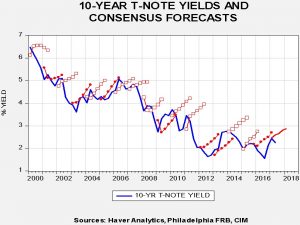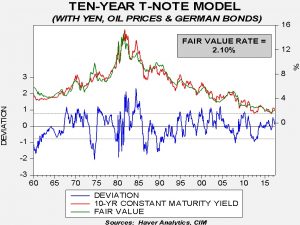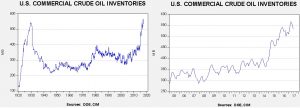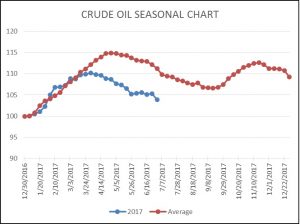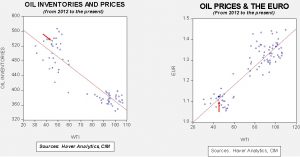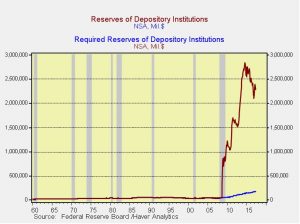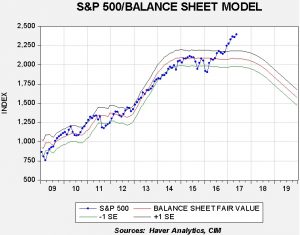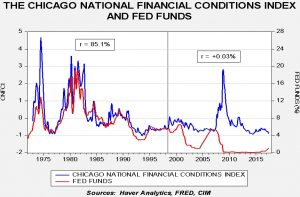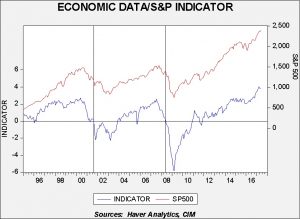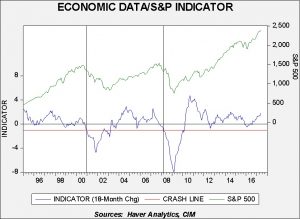by Bill O’Grady and Thomas Wash
[Posted: 9:30 AM EDT] It’s another quiet summertime morning. Here are the headlines we are watching:
It’s official—Randal Quarles is likely the newest Fed governor: The Trump administration formally nominated Quarles for the chair vacated by Dan Tarullo. His name has been in the media for several weeks, so the actual news wasn’t a surprise (since the GOP controls the Senate, his approval is a virtual lock). In fact, the surprise is that it took this long to make it official. It seems the administration wanted to fill all three openings at once; however, it was struggling to come up with a third candidate who would represent the community banks (it is widely expected that Marvin Goodfriend will also be nominated soon). We expect Quarles to be bank friendly; he has supported lower capital requirements and has mostly represented the industry in his private law career. He has also supported rules-based monetary policy, although there isn’t a lot of evidence that this is a core belief that would turn him into a hawk. Overall, we look for moderate voting pattern from Quarles until proven otherwise.
U.S. to move unilaterally on North Korea: The WSJ is reporting[1] that the administration is unilaterally tightening sanctions on the Hermit Kingdom and targeting Chinese companies and banks that do business with the Kim regime. The Treasury is specifically going after offshore dollar accounts held by North Korea with the cooperation of Chinese companies. We have doubts that these moves will make much difference but it does suggest the White House is in no hurry to engage North Korea militarily. The same paper has an interview with Robert Gates on how he would address the North Korean problem; as one would expect, it relies on China to bring the Kim regime to heel.[2] There’s a lot to like in the Gates proposal. One thing we would add—if China fails to deliver, the U.S. would support strategic nuclear weapons in Japan. Nothing would get China’s attention faster.
War games: The U.S., Japanese and Indian navies are holding exercises in the Indian Ocean. The People’s Liberation Army Navy has been sending an increasing number of warships into the Indian Ocean, raising India’s concerns. Sea lanes are a critical part of China’s “one belt, one road” trade route goal and India is a potential road (or better, “sea”) block to completing this goal. India has historically focused on its northern border with China as a security threat (India’s primary threat remains Pakistan), but is now realizing that the PRC’s rapidly improving blue water navy means it is now facing a southern naval threat as well. India’s response appears to be to team up with the U.S. and Japan to constrain China. We note that Australia has traditionally participated in these exercises but pressure from China led the country to withdraw from the games. The fact that China’s economic influence is affecting how Australia manages its participation in regional security is a worry.
Rising U.S. oil exports: The FT[3] is reporting that an influential study says the U.S. will be exporting more oil than most OPEC members by 2020. Surging U.S. production and changes in trade regulation are expected to boost exports to perhaps four times the current level by the aforementioned year. According to the report, U.S. exports could reach 2.3 mbpd by 2020, which would exceed the exports of all OPEC members except for the UAE, Iraq and Saudi Arabia. The U.S. is rapidly becoming a supply threat to OPEC and, over the longer term, lower oil prices are probably inevitable. However, in the near term, the Saudi IPO will likely keep prices mostly in the $45 to $55 price range.
The battle for bitcoin: Although this issue is well known among the cryptocurrency cognoscente, there is a rapidly rising ideological split in the bitcoin community. The issue, simply put, is whether the cryptocurrency should evolve into a payment system that would be used by mainstream corporations and the financial system or whether it should be a libertarian alternative to precious metals. When bitcoin was created, to protect it from cyber-attacks, the design put a ceiling on the number of transactions the blockchain (the distributed ledger of transactions) could process. As bitcoin has become more popular, this limit has slowed processing times and processing fees have increased. This has made bitcoin less popular as a medium of exchange; simply put, a credit card within the banking system is looking more attractive as a means of payment. To create bitcoin, “miners” process algorithms using large computers; the miners want to solve the problem by boosting the size of each blockchain. The other proposal, supported by the developers of the bug-proof software, is to move some of the ledger data off the blockchain to be managed outside the network. A compromise is possible. The miners could get a partial increase in the blockchain size in return for moving some of the data off the main network. The key date is August 1. On that day, the majority of miners must adopt a new protocol called “SegWit.” If they don’t, it is possible that two versions of bitcoin could begin circulating. Although bitcoin remains a bit of a sideshow in the financial system, a breakdown could have unexpected effects in the financial system. We will continue to monitor this issue.[4]
[1] https://www.wsj.com/articles/u-s-prepares-to-act-alone-against-north-korea-1499707831?utm_source=newsletter&utm_medium=email&utm_campaign=newsletter_axiosam&stream=top-stories
[2] https://www.wsj.com/articles/what-would-gates-do-a-defense-chiefs-plan-for-north-korea-1499697227?tesla=y
[3] https://www.ft.com/content/96df15aa-65b7-11e7-8526-7b38dcaef614?emailId=5964507e4c37ad0004e739fb&segmentId=22011ee7-896a-8c4c-22a0-7603348b7f22
[4] https://www.bloomberg.com/news/articles/2017-07-10/bitcoin-risks-splintering-as-civil-war-enters-critical-month



